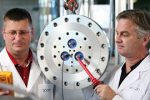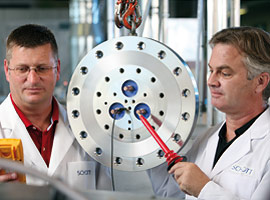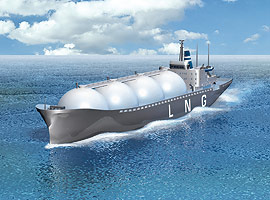The demand for natural gas is on the rise – and with it the need for appropriate means of transportation. But, because pipelines are expensive, often cross through crisis regions and put suppliers in a position to cut off the supply rather easily, the manufacturing and consuming countries are increasingly relying on ships to transport the raw material inside four or five huge tanks, after it has been liquefied by reducing its temperature. Around 270 such tankers are currently sailing on the world’s oceans, another more than 130 have already been ordered and should be launched by the year 2011. 45 of these are for Qatar alone, the world’s largest producer of liquefied gas.
In order for it to be shipped, the gas is liquefied by cooling it down to minus 165 degrees Celsius and then pumped into the tanks on board the ship. This means that 600 times as much gas can be stored in comparison with normal temperature. While it is being pumped, liquefied gas is subjected to high pressure of up to 150 bar. The chassis and internal electric motors of the pumps that are a permanent component of the tank’s cladding are immersed in liquefied gas. For this reason, they must be sealed perfectly, particularly where the electrical connections from the deck of the ship lead into the pump.
Here, SCHOTT relies on a technique called compression seal. “This calls for both the glass isolator and the copper conductor to be placed inside a stainless steel housing and then be heated up so that all of the elements melt together,” explains Dr. Oliver Fritz, Technical Manager for Large Scale Feedthroughs at SCHOTT Electronic Packaging in Landshut, Germany. “As the assembly cools down the glass solidifies and the stainless steel housing contracts to a greater degree than the glass. Due to the differences in the coefficients of thermal expansion of the materials used, the glass isolators are subjected to compression and a hermetic joint is created,” he adds.
Later, when the cold liquefied gas flows through pump, the stainless steel contained in the housing of the feedthrough continues to contract and exerts even more pressure on the glass and, thus, helps ensure that it remains sealed. Unlike the epoxy grouting used by competitors, the pressure barrier in the glass version that SCHOTT relies on does not contain any organic ingredients that age rapidly in response to the severe temperature cycling and, thus, lose their hermeticity. In comparison with hermetic pressure barriers that feature a ceramic-metal bond, glass feedthroughs are less likely to experience breakage.
Because feeding electrical conductors through to the submerged pump represents a rather sensitive area, SCHOTT adheres to the highest possible safety standards during manufacturing. “We are capable of supplying all types of products together with certification in accordance with the European ATEX standard and the international IEC standard for electrical safety,” Ulrich Dirr, Sales Manager for Large-Scale Feedthroughs at SCHOTT Electronic Packaging, notes. “Before it is shipped, each and every liquefied glass feedthrough is subjected to one and a half times the maximum required design pressure and then tested for density using helium mass spectrometers. Testing for electric strength and insulation guarantee reliable performance at voltages of up to 6,600 volts and flows of 600 amperes,” he adds.
Thanks to the technology of compression glass-to-metal sealing that SCHOTT has succeeded in perfecting by optimizing material combinations and manufacturing processes for these extreme applications, the company has captured the technology leader position this market. SCHOTT started manufacturing the first glass-to-metal feedthroughs for liquefied gas applications 25 years ago. These products are still doing their jobs today without requiring any maintenance or causing any problems.




